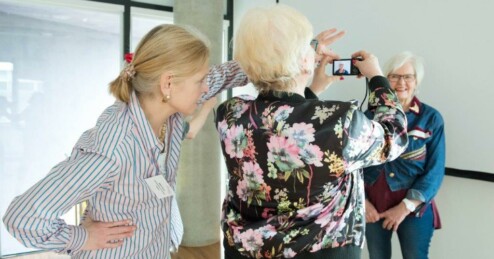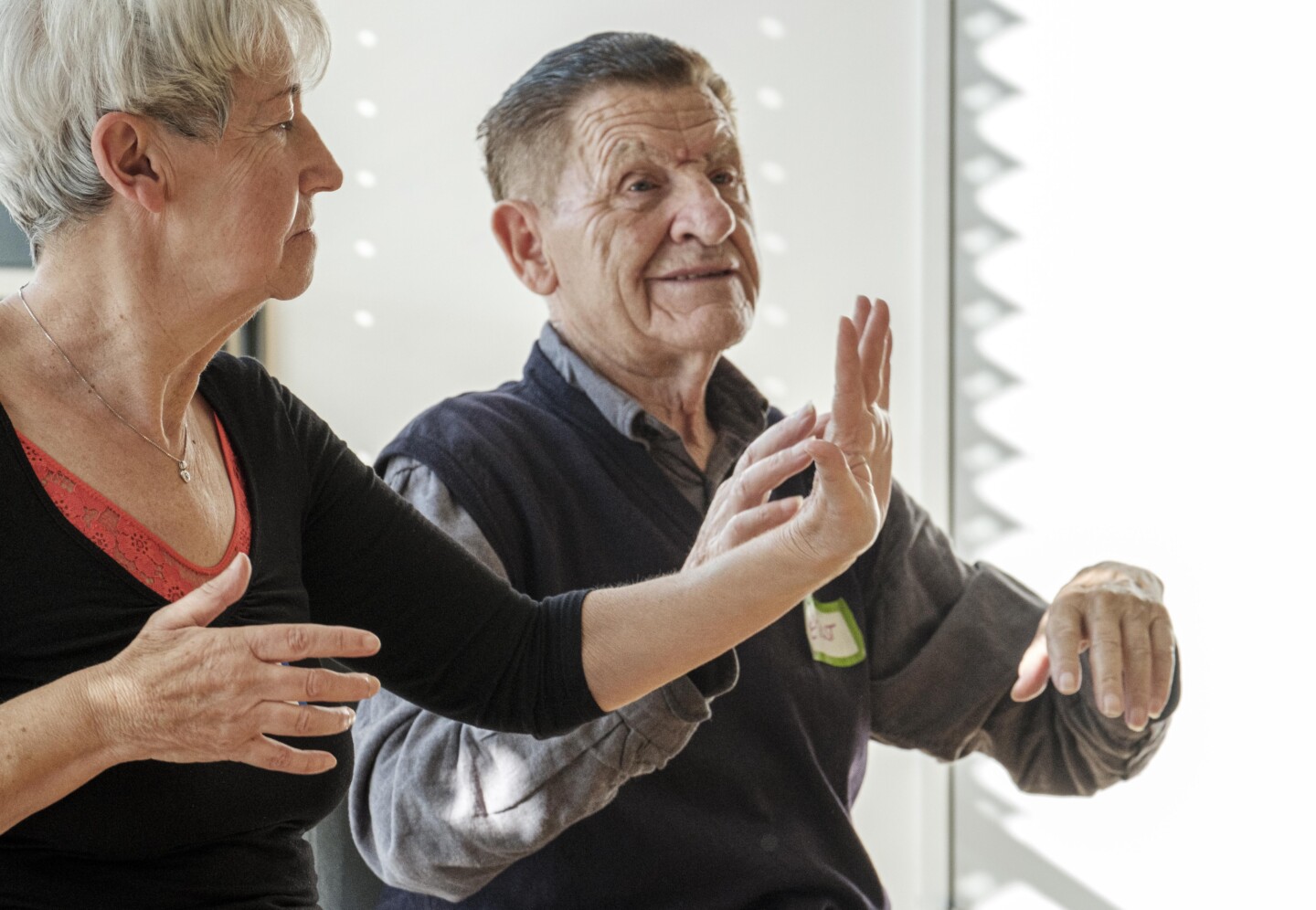
Age-friendly communication – Addressing the target group in cultural geragogy
What is important when publicising a cultural education programme for older people?

What is cultural education and why is it also important for older people? This article explains fundamentally what role cultural education can play in the lives of old and very old people and what social significance it therefore has.
The German Federation for Arts Education and Cultural Learning (Bundesvereinigung Kulturelle Kinder- und Jugendbildung – BKJ) defines the term “cultural education” as follows:
Cultural education is personal development using forms of cultural expression, arts and playing. It is a prerequisite for cultural participation. It is general education because it enables children and young people to relate to themselves and to the world through playing, arts and culture.
What applies to children and young people applies in principle to people of all ages. Because research shows: Even in old age we can change and develop. Our personality is not fixed at some point, but is influenced by our environment, our social roles and the people we surround ourselves with. Cultural education can give impulses to explore and expand one’s own biography. New skills can be learned in a meaningful way with the help of cultural education in old age. In addition, social contacts can be deepened and expanded.
Cultural education encompasses the process of learning and engaging with oneself, one’s environment and society with the help of art and culture. It takes place,
Cultural education does not only happen theoretically: it often involves the whole body, feelings and mind. The contexts and cultural expressions that become the subject of cultural education can be very different. As a result, cultural education means the ability to participate in culture-related communication, with positive consequences for social participation as a whole.
Cultural education is not bound to specific institutions, but takes place in different places and in a variety of forms. In some institutions, cultural education is one of the central tasks – e.g. in theatres and opera houses, museums, music schools, cultural centres and associations, libraries and public broadcasting stations. But it also takes place in many other areas and offers – e.g. in old people’s homes, meeting places and day centres for senior citizens as well as multi-generation houses. These offers are often organised by initiatives and associations, but also by individuals. Last but not least, cultural education also “happens” in the private and family environment, e.g. when playing with the grandchildren, reading or surfing the internet.
There are many opportunities for cultural education programmes. For example:
The following arguments support the promotion and expansion of cultural education for older people:
The right to cultural participation is guaranteed by universal human rights (UDHR, Article 27, 1). According to the Social Code XII, it must be made possible for older people in Germany, irrespective of their income and assets, not only to receive advice and support as well as invitations to social gatherings, but also to be offered education and culture as well as opportunities for social engagement (section 71, paragraph 2, Social Code XII).
One of the most important goals of cultural education in old age is to enable social and cultural participation. To this end, framework conditions must be created that enable older people to participate in high-quality arts and cultural education, regardless of their physical, psychological and cognitive conditions, their origins, their gender identities and their living situations and places of residence.
Cultural education practice offers opportunities to reshape images of age(ing) and to change, develop and also question roles, identities and positions. New perspectives emerge in the confrontation with other designs for a good life in old age.
For many older people, cultural education offers a way to reorient themselves in the post-family and post-professional phase and to find individual possibilities of meaningful life design and social engagement. Older people engage creatively and artistically with themselves and the world together with others and, if necessary, change their views of themselves and the world as well as their views of age. They create something that has meaning for them, share it with others and make creativity in old age publicly visible.
Wenn ältere Menschen an Angeboten der kulturellen Bildung teilnehmen, können sie Stärken und Fähigkeiten an sich entdecken und entwickeln, die ihnen vielleicht noch gar nicht bewusst sind. Sich selbst unabhängig vom eigenen Lebensalter als lernfähig, erfinderisch und wirksam zu erleben, fördert den Mut und die Lust, sich neuen Herausforderungen zu stellen. Kulturelle Bildung wirkt empowernd, stärkt das Vertrauen in die eigenen Möglichkeiten und regt zur Reflexion von Gestaltungsspielräumen an.
Cultural education offers senior citizens the opportunity to pursue individual questions and interests. They can delve into topics that occupy them and for which they may not have had time in other phases of their lives due to work and family commitments. They can have learning experiences free from external pressures. In cultural education, education and learning can be experienced as something beautiful and playful that one can shape oneself.
Cultural education enables people to get to know, try out, learn and deepen cultural forms of expression. These are constantly changing, not only through digitalisation and digital forms of communication. In the practice of cultural education, older people can experiment in analogue and digital worlds, explore them and link them. In this way, people can acquire additional knowledge about digital media or deepen existing knowledge, regardless of their previous experience. Digital media and social practices of media use can also be critically reflected upon in the context of cultural education.
Culture, arts and aesthetic experiences offer the chance to look at the world from new angles. They encourage us to question the familiar, to adopt unfamiliar perspectives and to consider that there can be different answers to a question and different solutions to a problem.
Cultural education offers opportunities to explore one’s own experiences. These can be experiences and memories of happiness, but also of disappointment, sadness or loss. Cultural education in old age enables people to work on their own biography, to shape biographical transitions in old age and also to process critical life events.
In cultural education programmes, older people can express their individual perspectives. They can show themselves and others how they experience themselves and the world and what they think about it. In a creative and open environment, different perspectives, backgrounds and cultural imprints can be addressed, reconsidered and expressed in the medium of the arts. Prejudices and stereotypes can be broken down more easily and cultural, generational or social differences can be bridged. Social practices with which we make distinctions in the first place are also perceived more consciously in this way.
Cultural education opens up spaces for generational encounters, generational dialogues and intergenerational learning. Due to demographic change and the fact that families sometimes live far apart, intergenerational contact zones are often lacking. The major social transformation processes of our time – demographic change, the distribution of care work, diversity and identity policy, dealing with the Corona pandemic and, last but not least, dealing with climate change – have been and are being discussed in public also under the sign of generational conflicts. Cultural education in old age involves intergenerational learning, which is about dealing with generational ambivalences, intergenerational justice and sustainability.
Cultural participation promotes social interaction, broadens horizons and enables new encounters and contacts. Within the framework of cultural education and cultural activities, older people can make new social contacts, actively participate in social life and get involved in their environment.
Those who volunteer in culture in old age can contribute their skills, knowledge and wealth of experience. Thus, cultural education in old age not only promotes participation, but also the involvement of older people in the cultural sphere.
Cultural education enables older people to engage with cultural heritage. They can preserve and cultivate their own history and traditions. In intergenerational and transcultural dialogue, however, they can also reflect on them critically: What is considered cultural heritage and what is excluded from it? What should be passed on and how can it be communicated? This debate promotes awareness of different cultural and generational perspectives on cultural heritage and its transmission.
Cultural education has been shown to have positive effects on the health and well-being of older people. Creative activities can promote cognitive skills, improve motor coordination and maintain mental agility.
In addition, cultural education can serve to prevent physical and mental illness in old age by preventing social isolation and promoting mental activity. Those who participate in cultural education programmes in old age are less likely to experience loneliness and depression. This is why “culture on prescription” has also been discussed for some time and is currently being tested.
Cultural education and cultural projects enable older people to critically and creatively engage with their own self-image, social images of age and age discrimination, cultural heritage, the current social situation and future perspectives. Older people are thus encouraged to develop visions based on their extensive knowledge of experience and to help shape social developments.
Art and culture offer ways to bring the knowledge of older people into society and to make the competences of older people more visible to the public. In this way, older people experience more public recognition and resonance.
Cultural education in old age is thus important because it enables older people to develop their personality, deepen social contacts, pursue personal interests and engage with cultural heritage. It also promotes health and well-being, stimulates generational dialogues and enables older people to actively participate in shaping society and to become visible.
Bundesvereinigung Kulturelle Kinder- und Jugendbildung (BKJ) (o. J.): Was ist Kulturelle Bildung? (letzter Zugriff am 22.09.2023)
Ermert, Karl (2009): Was ist kulturelle Bildung? In: Bundeszentrale für politische Bildung: Kulturelle Bildung (letzter Zugriff am 22.09.2023)
Fricke, Almuth/Haller, Miriam (2023): Alter spielt (k)eine Rolle! Kulturpolitik für ältere Menschen. In: Crückeberg, J., Heinicke, J., Kalbhenn, J., Landau-Donnelly, F., Lohbeck, K., Mohr, H. (Hrsg.): Handbuch Kulturpolitik. Wiesbaden.
Fuchs, Max (2015): Partizipation als Reflexionsanlass. In: Kulturelle Bildung Online (letzter Zugriff am 22.09.2023)
Groote, Kim de (2013/2012): Kulturelle Bildung im Alter. In: Kulturelle Bildung Online (letzter Zugriff am 22.09.2023)
Groote, Kim de/Fricke, Almuth (2010): Kulturkompetenz 50+. Praxiswissen für die Kulturarbeit mit Älteren, Kopaed, München 2010.
Haller, Miriam (2022): Un/Doing Generations – Generationendifferenzen in der intergenerationellen Kulturellen Bildung, in: Kulturräume+. Das kubia-Magazin, Heft 23/2022